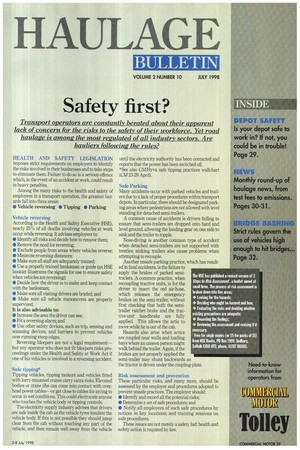HAULAGE
Page 31

If you've noticed an error in this article please click here to report it so we can fix it.
BULLETIN
VOLUME 2 NUMBER 10 JULY 1998
Safety first?
Transport operators are constantly berated about their apparent lack of concern for the risks to the safety of their workforce. Yet road haulage is among the most regulated of all industry sectors. Are hauliers following the rules?
HEALTH AND SAFETY LEGISLATION imposes strict requirements on employers to identify the risks involved in their businesses and to take steps to eliminate them. Failure to do so is a serious offence which, in the event of an accident at work, could result in heavy penalties.
Among the many risks to the health and safety of employees in a transport operation, the greatest hazards fall into three areas: • Vehicle reversing • Tipping • Parking Vehicle reversing According to the Health and Safety Executive (HSE), nearly 25% of all deaths involving vehicles at work occur while reversing. It advises employers to: • Identify all risks and decide how to remove them; • Remove the need for reversing; • Exclude people from areas where vehicles reverse; • Minimise reversing distances; • Make sure all staff are adequately trained; • Use a properly trained banksman or guide (an HSE booklet illustrates the signals for use to ensure safety when vehicles are reversing); • Decide how the driver is to make and keep contact with the banksman; • Make sure all visiting drivers are briefed; and • Make sure all vehicle manoeuvres are properly supervised. It is also advisable to: • Increase the area the driver can see; • Fit a reversing alarm; and • Use other safety devices, such as trip, sensing and scanning devices, and barriers to prevent vehicles over-running steep edges.
Reversing bleepers are not a legal requirement— but any operator who does not fit bleepers risks proceedings under the Health and Safety at Work Act if one of his vehicles is involved in a reversing accident.
Safe tipping* Tipping vehicles, tipping tankers and vehicles fitted with lorry-mounted cranes carry extra risks. Elevated bodies or crane jibs can come into contact with overhead power cables—or get close to cables for arcing to occur in wet conditions. This could electrocute anyone who touches the vehicle body or tipping controls.
The electricity supply industry advises that drivers are safe inside the cab as the vehicle tyres insulate the vehicle body. If this is not possible they should jump clear from the cab without touching any part of the vehicle, and then remain well away from the vehicle until the electricity authority has been contacted and reports that the power has been switched off. *See also CM/Hyva safe tipping practices wallchart (CM 23-29 April).
Safe Parking Many accidents occur with parked vehicles and trailers due to a lack of proper procedures within transport depots. In particular, there should be designated parking areas where pedestrians are not allowed with level standing for detached semi-trailers.
A common cause of accidents is drivers failing to ensure that semi-trailers are dropped onto hard and level ground, allowing the landing gear on one side to sink and the trailer to topple.
Nose-diving is another common type of accident when detached semi-trailers are not supported with trestles; sinking trailers also cause problems when attempting to recouple.
Another unsafe parking practice, which has resulted in fatal accidents, is the failure to apply the brakes of parked semitrailers. A common practice, when recoupling tractive units, is for the driver to insert the red air-hose, which releases the emergency brakes on the semi-trailer, without first checking that both the semitrailer ratchet brake and the tractive-unit handbrake are fully applied. This allows the artic to move while he is out of the cab.
Hazards also arise when artics are coupled near walls and loading bays where an unseen person might walk behind the trailer. Again, if the brakes are not properly applied the semi-trailer may shunt backwards as the tractor is driven under the coupling plate.
• Looking for the hazards; • Recording the findings;
Risk assessment and prevention These particular risks, and many more, should be assessed by the employer and procedures adopted to prevent unsafe practices. The employer should: • Identify and record all the potential risks; • Determine a set of safe procedures; and • Notify all employees of such safe procedures by notices in key locations; and training sessions on safe procedures.
These issues are not merely a safety fad: health and safety action is required by law.












































































































